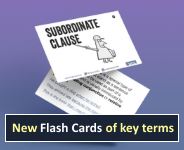Grammar
We define grammar as the study of the structure of words and sentences. As such it is an abstract system, worthy of study in its own right. However, we also see grammar as a system that is used in a range of contexts to unlock meaning. We want to look at grammar not only in written language, but also in spoken English, in a range of multimodal forms, and in all its rich variety. The grammar we are looking at here is not about making judgements about expressions, or speakers being right or wrong, but about exploring the structure and meaning of what is said or written in many different settings.
To do that we need a toolkit, and the terminology we use to describe grammatical structures is an important part of that. But the terminology isn’t the be-all and end-all of what we’re doing here. A toolkit is not really much use on its own: we need something to use it on.
That is why, in the grammar exercises and explanations we provide on this site, we try to use as many examples of real language as we can. Many of these are sourced from the ICE-GB corpus, a collection of over a million words of natural English, sampled from real life, much of it representing speech. So instead of making up abstract examples which illustrate a grammatical point, we try to find examples that have actually been written or spoken. And instead of telling people what to do, we act as language detectives investigating what people do in real life, and describe it.
Welcome!

Englicious is totally free for everyone to use!
But in exchange, we ask that you register for an account on our site.
If you’ve already registered, you can log in straight away.
Since this is your first visit today, you can see this page by clicking the button below.
- Printer-friendly version
- Log in to view or leave comments

